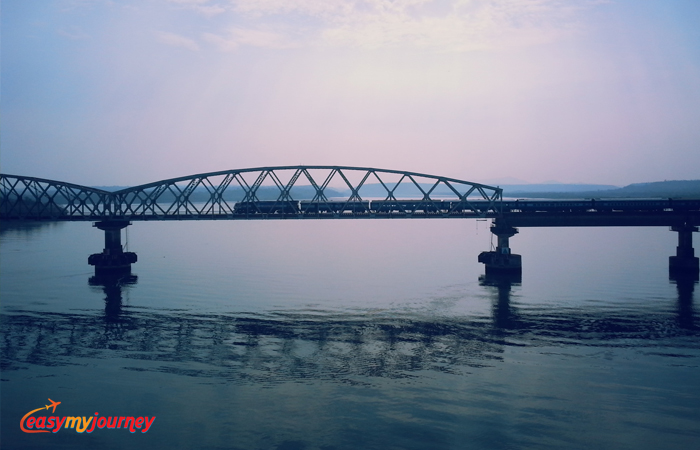Initially named as Panjim by the Portuguese, Panaji literally means ‘The Land that never floods’ and is the state capital of Goa. Unlike the other state capitals, Panaji is an unhurried town that is peaceful and laid back. With a Portuguese style setting, the town has concrete structures, red titled roof, promenades and churches. Panaji lies on the peninsula looking out on the vast Mandovi River where one can see the boats cruising. The boulevards are lined up with arrays of acacia and gulmohar trees. The vibrantly glowing alleys with modernized cafes, back street bars and the narrow avenues of the Latin Quarter, Panaji is a place that is lively yet peaceful at the same time. With majestic churches, alleys, terracotta roofs and the flavour of Goan culture, the place resembles Lisbon, its twin sister in Portugal. Panaji is an Indian city with a heavy mesmerizing influence from the foreign land of Portugal.
Places to Visit in Panaji
Our Lady of the Immaculate Conception Church : Sitting over a small hillock in the form of a grand white wedding cake, the church of Our Lady of the Immaculate Conception was initially a little chapel that as built in 1541. The church was reconstructed in the mid-17th century again from the basic foundations. The white washed church houses the second largest bell in Goa that weighs about 2,250 kg and was originally a part of Augustinian Monastery. The symmetric staircase that sits in the front of the church was constructed in the nineteenth century. The interiors of the church are simplistic yet impressive. The main altar is dedicated to Mary whereas the two side altars are dedicated to Jesus’s Crucifixion and Our Lady of the Rosary respectively. The church is the first church of Goa and hence has significant spiritual connection with the city.
Basilica of Bom Jesus : The Basilica of Bom Jesus is one of the oldest churches in India. Construction of the church began in the last decade of the sixteenth century and it was sanctified in 1605. The monument, declared as a world heritage site by the UNESCO, is one of the finest examples of the baroque architecture. The chassis of St. Francis Xavier is kept in a beautifully decorated casket here in the basilica. The remains of the saint are considered sacred and are believed to have inexplicable healing powers. It is a holy place for all the Christian devotees round the globe that come in a large number to visit this basilica every year.
Se Cathedral : Shorted for Sé Catedral de Santa Catarina, Se Cathedral is the largest church in India and also one of the largest churches in Asia. The church is devoted to Catherine of Alexanderia. The façade is 35 m high. With a typical Tuscan exterior and the interiors done in Corinthian style the cathedral is a fine example of Portuguese-Gothic style of architecture. The cathedral came into existence in 1619AD but was sanctified in 1940 AD. The tower also houses the largest Bell in Goa, usually referred as ‘Golden Bell’. With simplistic interiors the cathedral draws a lot of tourists to pay homage.
Dr. Salim Ali Bird Sanctuary : Entrenched in the low mangrove forests on the western edge of the Chorao Island, Dr. Salim Ali Bird Sanctuary is spread in an area of about 440 acres. Due to its splendid geographical location banking on the Mandovi River, the place is home to local and migratory avifauna. The sanctuary is accessible by a ferry ride and pathways in the mangrove swamp forests are paved to walk through the sanctuary. The sanctuary remains restricted during the times of high tides. It also houses a watch tower to have a better of the birds. Fiddler crabs and mudskippers are an easy spot with some other species of mangrove habitat. Birds like red knot, little bittern, pintails and coots can be seen here.
Goa State Museum : Goa state museum is a display of the evolution of the history and culture of the Goan Culture. With a wide variety of artefacts that belong to different eras in the history of Goa, the museum thematically shows the importance of the traditions of the locals at different points in time. The Museum was first established in St. Inez in 1977AD, initially at a small scale and then was shifted to EDC Complex in Patto in June 1996. With about 14 themed galleries the Goa State Museum is a window connecting the past and the present.
Best Time to Visit Panjim
The best time to visit Panaji is between late October and early April. This is very pleasant time to go sightseeing in the charming Fontainhas which to date retains it's Portugese flavour. The peak season for travel in Panaji and Goa is from mid-December to mid-January, when the weather is near perfect, and temperatures remaining under 32° C. The nights sometimes gets chilly in December-January, especially if you are on the beaches, so carrying a light shawl or wrap is a good idea.
The carnival period in the month of February through early March is another peak time, attracting a lot of tourists to North Goa and Panaji.
How to Reach Panjim?
By Air : Goa’s airport is Dabolim which is 29 kilometers south of Panaji. This airport has chartered flights which usually come in from Europe and from major parts of the country such as Mumbai, Delhi, Chennai, Bangalore, Thiruvanthapuram and Kochi which makes how to reach Goa- Panaji easy.
By Rail : Nearest train station is located at Margao which is approximately 39 kilometers away. Travelers can easily hire a taxi or take a bus from the railway station to reach Panaji.
By Road : The Kadamba Bus Terminal is located in Pato which is approximately 1 kilometers east of the main square. It is one of the busiest bus junctions with buses that come in from neighboring towns. These bus terminals are located at a long distance from Maharashtra and Karnataka.

